#1946-1970 english
Explore tagged Tumblr posts
Text
youtube
King Crimson Live In Japan full concert
Oct. 5th/6th 1995 Nakano Sunplaza Hall. Tokyo (中野サンプラザ/なかのサンプラザ)
1 Intro 1:18 2 VROOOM 3:02 3 Frame By Frame 9:45 4 Dinosaur 14:58 5 One Time 21:55 6 Red 27:40 7 B'Boom 33:56 8 THRAK 41:10 9 Matte Kudasai 47:40 10 Three Of A Perfect Pair 51:06 11 VROOOM VROOOM 55:26 12 Sex, Sleep, Eat, Drink, Dream 1:00:26 13 Stick Duet 1:05:10 14 Elephant Talk 1:07:10 15 Indiscipline 1:11:32 16 The Talking Drum 1:18:18 17 Larks' Tongues In Aspic Part II 1:21:30 18 People 1:28:00 19 Walking On Air 1:33:43


📌 Crimson is a rich, deep red color, inclining to purple. It originally meant the color of the kermes dye produced from a scale insect, Kermes vermilio, but the name is now sometimes also used as a generic term for slightly bluish-red colors that are between red and rose. It is the national color of Nepal.
緋紅色,也稱緋色,是紅色摻帶少許藍色後產生的一種色彩,傳統上是用來形容血液的顏色。緋紅色之英語源於梵語"krmi-ja"(暗深红色)得來的,溫暖之意。實際上是由一種在地中海橡樹上發現的胭脂蟲製成。傳說中是由留著長指甲的女人(視力也得很出眾)負責蒐集蟲子。「由戶蟲生產的紅色染料」的意思。🧐 very interesting about "Crimson red". ❤
ps. 佛教裡的戶蟲,就是人體內的微生物、細菌。
The album 《 In the Court of the Crimson King 1969》 cover works - "Schizoid Man" by Barry Godber (English, 1946-1970).
📌 Barry Godber, a computer programmer who painted the iconic artwork for King Crimson's debut LP. Godber died from a heart attack in February 1970, shortly after the album's release. It was his only album cover. The original painting is now owned by Robert Fripp.
#king crimson#progressive rock#prog rock#art rock#experimental rock#post-progressive#live/japan#full concert#gif by justbeingnamaste#thank you#schizoid man#barry godber#1946-1970 english#Youtube
6 notes
·
View notes
Text
Carroll O'Connor

Physique: Average/Husky Build Height: 5′ 10½″ (1.79 m)
John Carroll O'Connor (August 2, 1924 – June 21, 2001; aged 76) was an American actor whose television career spanned over four decades. O'Connor found widespread fame as Archie Bunker (for which he won four Emmy Awards), the main character in the CBS television sitcoms All in the Family (1971–1979) and its continuation, Archie Bunker's Place (1979–1983). O'Connor later starred in the NBC/CBS television crime drama In the Heat of the Night (1988–1995), where he played the role of police chief William "Bill" Gillespie. In the late 1990s, he played Gus Stemple, the father of Jamie Buchman (Helen Hunt) on Mad About You. In 1996, O'Connor was ranked number 38 on TV Guide's 50 Greatest TV Stars of All Time. He won five Emmys and one Golden Globe Award.
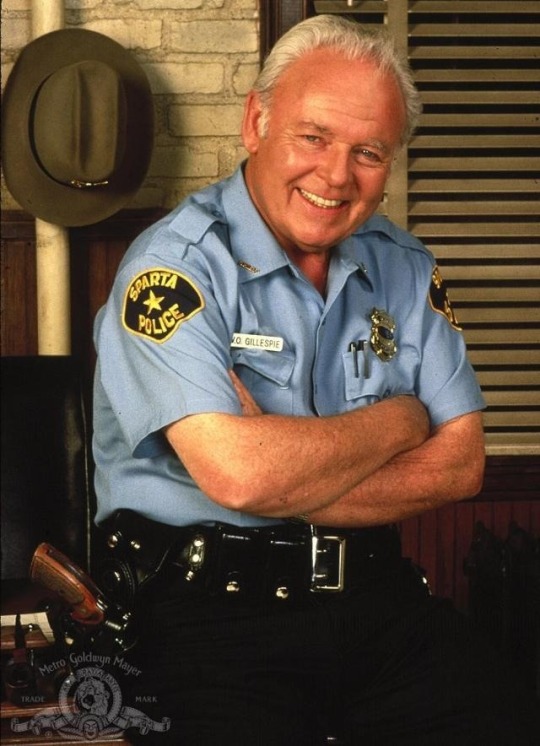

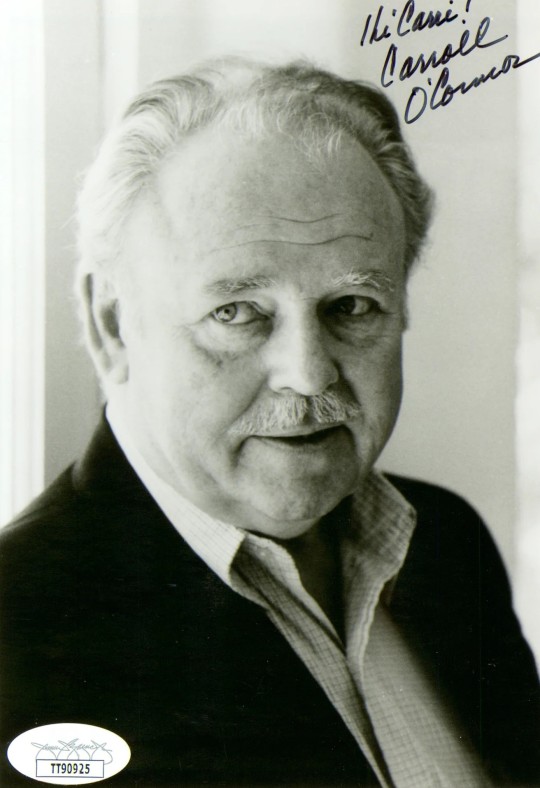
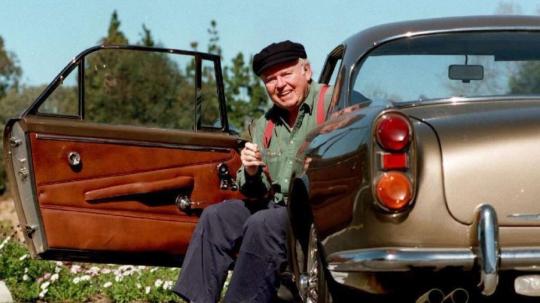

Carroll was born in Manhattan and raised in Forest Hills, a borough of Queens, New York. After graduating from high school in 1942, O'Connor joined the Merchant Marines and worked on ships in the Atlantic. In 1946, he enrolled at the University of Montana to study English. While there, he became interested in theater. During one of the amateur productions, he met his future wife, Nancy Fields, whom he married in 1951. They would later adopted their only child while in Rome, Italy in 1962 while he filmed Joseph L. Mankiewicz’s Cleopatra.


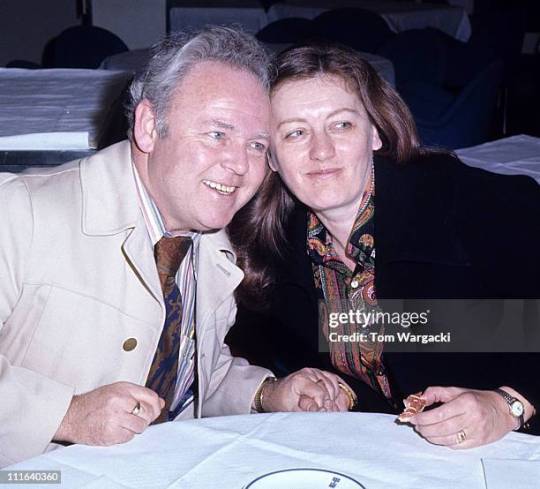


I first fell in lust with O'Connor for his role as crusty police chief William 'Bill' Gillespie on the crime drama "In the Heat of the Night." O'Connor captured my imagination so much that he still remains one of the key templates of what a daddy should be like to me. Chubby, grey hair, gentle features but with a hint 'I'll fuck you up if you cross me' added for good measure. But as hot as he looked on the show, he looked insanely gorgeous as Archie on reruns of "All in the Family." Yes a rarity for me. Liking a man when they were younger.


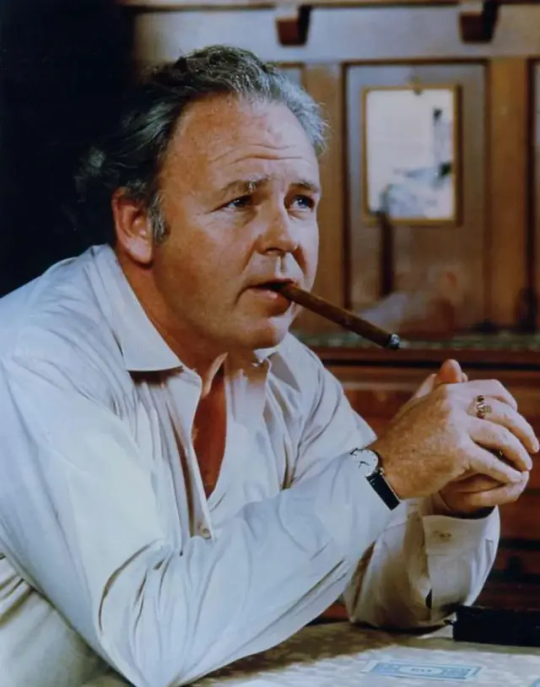
Even though O'Connor was nothing like his alter ego, Archie. Being shy, soft-spoken, introverted, intellectual and liberal. He had a charm that would have had me on my knees in minutes of speaking with him. Just sheer daddy perfection. He may not have been traditional-leading-man handsome, but I’ve always found Mr. O'Connor as nice looking. Listed as #20 on TV Land’s Top 50 TV Icons Countdown, but in the top five on my all time actors that I’d like to fuck senseless. O'Connor died at the age of 76 on June 21, 2001, in Culver City, California, from a heart attack brought on by complications from diabetes.

RECOMMENDATIONS: Return to Me (2000) In the Heat of the Night (TV Series 1988–1995) Archie Bunker's Place (TV Series 1979–1983) All in the Family (TV Series 1971–1979) Law and Disorder (1974) Kelly's Heroes (1970) Waterhole #3 (1967)
76 notes
·
View notes
Text

Marianne Faithfull, singular icon of British pop, dies aged 78
Singer and actor overcame drug addiction and homelessness to collaborate with everyone from the Rolling Stones and Metallica to Jean-Luc Godard
Marianne Faithfull, whose six-decade career marked her out as one of the UK’s most versatile and characterful singer-songwriters, has died aged 78.
A spokesperson said: “It is with deep sadness that we announce the death of the singer, songwriter and actress Marianne Faithfull.
“Marianne passed away peacefully in London today, in the company of her loving family. She will be dearly missed.”
With a discography that spanned classic 60s pop tunes to the prowling synthpop of Broken English and onto collaborations with Nick Cave, Warren Ellis, Lou Reed and more, Faithfull was idolised by fans and fellow musicians alike, and was also celebrated across the worlds of fashion and film.
Mick Jagger, with whom she had a four-year relationship, said: “I am so saddened to hear of the death of Marianne Faithfull. She was so much part of my life for so long. She was a wonderful friend, a beautiful singer and a great actress. She will always be remembered.”
Born in 1946 in London, Faithfull was descended from Austrian nobility on her mother’s side – her great-great-uncle Leopold von Sacher-Masoch wrote the erotic novel Venus in Furs – but grew up in relatively ordinary surroundings in a terraced house in Reading.
After leaving for London in her teens, she met Rolling Stones manager Andrew Loog Oldham, who asked Mick Jagger and Keith Richards to write her 1964 debut single As Tears Go By, which hit the UK Top 10. She had three other Top 10 singles in 1965, all of which also reached the Top 40 in the US.
Faithfull also began acting at that time, appearing on stage in productions of Chekhov’s Three Sisters, alongside Glenda Jackson, and Hamlet, playing Ophelia with Anjelica Huston as her understudy and performing each night’s climactic “madness” scene, she later revealed, high on heroin.
On screen, she acted alongside Orson Welles, Oliver Reed, Alain Delon and Anna Karina, and played herself in Jean-Luc Godard’s 1966 film Made in the USA.
Her fame as an icon of “swinging London” was superseded, though, by the infamy that came from her relationship with the Rolling Stones. She had married the artist John Dunbar in 1965 and had a son, Nicholas, but soon left Dunbar for Mick Jagger.
She was often described as a muse for the band: she once told Jagger “wild horses couldn’t drag me away”, which became the chorus line to Wild Horses, and her drug struggles also proved inspirational for the songs Dear Doctor and You Can’t Always Get What You Want. She said: “I know they used me as a muse for those tough drug songs. I knew I was being used, but it was for a worthy cause.”
She co-wrote her song Sister Morphine, recorded with Jagger, Richards and Ry Cooder, and later recorded by the Rolling Stones for their album Sticky Fingers, but her writing credit was left off until she won a protracted legal battle.
Her addiction to cocaine and heroin worsened, and her reputation was damaged by being discovered naked, wrapped in a fur rug after having a shower, during a 1967 police search of Keith Richards’ house, alongside Richards, Jagger and six other men (described by one person as an innocent gathering “of pure domesticity”). “It destroyed me,” she later said. “To be a male drug addict and to act like that is always enhancing and glamorising. A woman in that situation becomes a slut and a bad mother.”
In 1970, Faithfull lost custody of her son, split with Jagger and became homeless, living on the streets of Soho in London as she tried to quit heroin. “I’d been living in a very fake sort of world in the 60s,” she said in 2016. “Suddenly, when I was living on the streets … I realised that human beings were really good. The Chinese restaurant let me wash my clothes there. The man who had the tea stall gave me cups of tea.” She slowly turned her life around, ending an almost decade-long spell away from music with the country album Dreamin’ My Dreams in 1976.
She cemented her comeback with one of her most acclaimed albums, 1979’s Grammy-nominated Broken English, embracing synthpop and postpunk with an affectingly raw, deepened voice. She quit drugs for good in 1985, and regularly released music throughout the rest of her career. Her collaborators over the years included Nick Cave, Damon Albarn, Emmylou Harris, Beck and Metallica. She released 21 studio albums.
Faithfull married and divorced two additional times, to Ben Brierly of punk band the Vibrators, and the actor Giorgio Della Terza. “I’ve had a wonderful life with all my lovers, and husbands,” she said in 2011, excepting Della Terza: “He was American, and he was a nightmare.”
There were other acting roles, too, notably playing God in two episodes of the sitcom Absolutely Fabulous; the devil in a 2004 production of The Black Rider, a musical by Tom Waits and William Burroughs; and Empress Maria Theresa in Sofia Coppola’s film Marie Antoinette.
In her later years she lived in Paris, and reacted to the 2015 terror attack at the city’s Bataclan concert venue, in which 90 people were killed, with a song called They Come at Night written on the day of the attacks.
Faithfull had numerous health issues. In 2007, she announced she had the liver illness hepatitis C, having been diagnosed 12 years previously. She had successful surgery following a breast cancer diagnosis in 2006, and weathered numerous joint ailments in her later years, including arthritis. In the early 1970s, she also suffered from anorexia during her heroin addiction. In 2020, she contracted Covid-19 and was hospitalised for 22 days.
She is survived by her son, Nicholas Dunbar.
Daily inspiration. Discover more photos at Just for Books…?
22 notes
·
View notes
Text

The Art Deco DREAMLAND cinema - Margate - UK
As for the history of the cinema, the complex sits on the site of a former theatre that dates back to 1923 and was part of the sprawling Dreamland Amusement Park run by English entrepreneur, John Henry Iles. The cinema, which was designed in the early 1930s, was closed for the duration of World War II and in 1940, along with the rest of the amusement park, was briefly used to accommodate troops evacuated from Dunkirk (26 May to 4 June). The cinema reopened in 1946 and continued to show only movies until the early 1970s. In 1973 Dreamland was subdivided into a live theatre on the ground floor and an independent cinema with two smaller screens in what was originally the circle. The live theatre didn’t take off, however, and in early 1975 was turned into a bingo hall. The bingo club closed in late 2007 and the independent cinema followed suit shortly after.
Restoration work on the cinema began in 2011 when the amusement park was purchased by new owners. But, financial difficulties and a legal battle over land ownership thwarted the project. Eventually, work on the building’s exterior was completed in 2016 after the site was compulsorily purchased by Thanet District Council. Restoration of the interior is ongoing but progress appears to be slow and future plans for this iconic Margate landmark are unclear.
36 notes
·
View notes
Text

Geoff Lace with gorse sticks, the Lhen, Isle of Man, 1970 - by Chris Killip (1946 - 2020), English
136 notes
·
View notes
Text
#memorial day


On November 24, 1991, Freddie Mercury passed away.
The great and unique singer, songwriter and frontman of "Queen", died of extensive pneumonia due to AIDS, at the age of 45. It is also worth recalling that he bequeathed to his colleagues to find a new singer and continue their creative activities.
There is a lot to say about the work of this Great musician...Let's just listen to his hits, which have left a vivid mark on the history of music...
Eternal Memory of the great musician🙏
Legends don't die. They live in their work and in our memory. Which means he will live forever💔
youtube


Freddie Mercury, born Farrukh Bulsara, was born on September 5, 1946 in Stone Town, Zanzibar. Farrukh's parents raised him in accordance with Persian culture. In 1954, his parents enrolled their son in St. Peter's School in Panchgani. In the early years of his studies, Farrukh's classmates came up with the idea of calling him Freddy. Freddie studied well, showing great interest in music and creativity, he drew well, sang in the school choir and participated in school productions. The headmaster drew attention to his abilities. For a fee, he offered to organize piano courses for Freddie. The parents agreed. Freddie got the opportunity to develop his rare talent. At the age of 12, Freddie became a member of the first band in his life, which he also organized - "Restless". The band performed at school parties, dances, and various events. Freddie participated in his band as a pianist. Soon the family moved to England, where Freddie enrolled in a polytechnic college. In the summer of 1969, he graduated with a well-deserved diploma and decided to seriously study music. One of his first English bands was the IBEX trio. At the end of 1969, the band broke up


In April 1970, his old friend Staffell decided to leave the SMILE band, to which Freddie had repeatedly invited him. Freddie took the vacant place of the vocalist. He changed the band's name to QUEEN and his last name to Mercury. This is how the legendary story of the "Queen" began, which successfully performed for many years. Since 1986, rumors began to appear that Freddie Mercury had AIDS. However, until the last days of his life, the musician denied all rumors about his health. Only close people knew about his terrible diagnosis. On November 23, 1991, Freddie made an official statement that he had AIDS. The next day, November 24, at about seven o'clock in the evening, Freddie Mercury died at his home in London

"I want to be remembered after my death as a musician who was worth something and achieved something. I do not know how I will be remembered. I didn't think about it — I died and died. No, I haven't thought about it. I really don't wonder like: "My God! When I die, will people remember me?" It's their business. When I die, who's going to care? Certainly not me."


#memorial day#Freddie Mercury#queen band#queen#legend#Rock#pop#arena rock#Spotify#music#my music#music love#musica#history music#spotify#rock music#rock#rock photography#my spotify#Youtube
11 notes
·
View notes
Text
L&L Scamander Headcanons:
Leander and Lycidas are the firstborn twin sons of Newt Scamander and Tina Goldstein.
They were born around 1946, a year after the marriage of their parents and the imprisonment of Gellert Grindelwald.
The boys enrolled at Hogwarts School of Witchcraft and Wizardry in the year of 1957.
Leander was sorted into Hufflepuff house like his father and uncle before him, while Lycidas was sorted into Ravenclaw.
I’ve decided that Lycidas should be in Ravenclaw due to the Goldstein family having ties to the house through an English relative, Anthony Goldstein.
Leander’s godparents are Jacob Kowalski and his father’s “indispensable” assistant Bunty Broadacre.
Lycidas’s godparents are Eulalie “Lally” Hicks and Theseus Scamander.
The only reason why Queenie isn’t the godmother of one of her nephews is because Tina wanted to wait until she had a daughter.
The twins grew up in England, but oftentimes visited their Kowalski relatives in America during the holidays.
For the most part both of the boys have British accents, but here and there you can sometimes hear their mother’s American twang slipping through, especially when they get excited or upset.
Leander and Lycidas were in their fourth year when Bellatrix Black enrolled at Hogwarts in 1962.
By the time Andromeda had began attending in 1964, the twins were already in their sixth year at Hogwarts.
With that being said, they didn’t have many interactions with the Black sisters as the twins were a bit older than the Marauders era.
I suppose in the original canon we could say that Leander and Lycidas were around when the Mcgonagall brothers were still at Hogwarts.
I’d pin Malcolm’s birth around 1940, and maybe Robert Junior would be a year or two younger than him so his year of birth would probably be 1942.
When the twins enrolled at Hogwarts Mal would’ve been seventeen, while Bob would’ve been fifteen.
But with the way HP canon is going right now we don’t actually know what years in which the Mcgonagalls were born, especially with Minerva’s plothole appearance in SoD.
Lycidas is a left-brainer, he is very strategical and thinks more with his head rather than his heart.
He is much like his uncle Theseus in this way, although Lycidas has a creative mind and is very skilled with charms.
This is something I’d think he would get from his godmother Lally.
I could see Lycidas maybe learning one of those portkey charms like the one Lally had with her book.
When he graduated Hogwarts, Lycidas planned on becoming an auror like Tina and Theseus.
Leander is the one who inherited his father’s compassionate nature and affinity with magical creatures.
He has a very sensitive soul and can be a little scatter-brained sometimes like Newt.
But one thing is for certain and that is not to underestimate him.
Leander has his mother’s stubbornness and his father’s inability to follow the rules.
Although these traits may be the culprit behind the countless detentions he’s received during his school years… oops.
Both Leander and Lycidas joined the Order of the Phoenix when Dumbledore first established it in the 1970s.
Lycidas is the father of Rolf Scamander, therefore making him the father-in-law of Luna Lovegood, as well as the grandfather of Lysander and Lorcan.
#hogwarts 1950s#hogwarts 1960s#malcolm mcgonagall#robert mcgonagall jr#minerva mcgonagall#lycidas scamander#leander scamander#artemis scamander#newtina#newt scamander x tina goldstein#bellatrix black#bellatrix lestrange#andromeda tonks#andromeda black#bunty broadacre#jacob kowalski x queenie goldstein#jacob kowalski#queenie goldstein#queenie kowalski#eulalie hicks#lally hicks#theseus scamander#anthony goldstein#gellert grindelwald#luna lovegood#rolf scamander#lysander scamander#lorcan scamander#scamander family
14 notes
·
View notes
Text
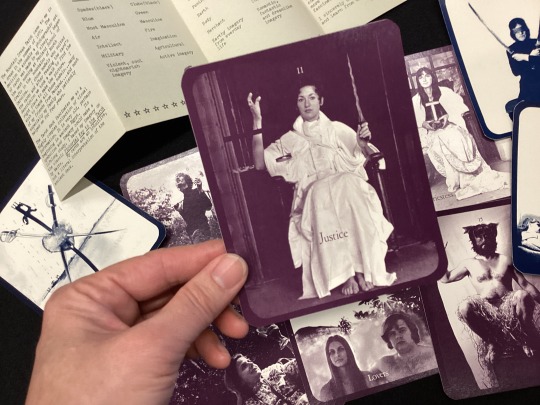



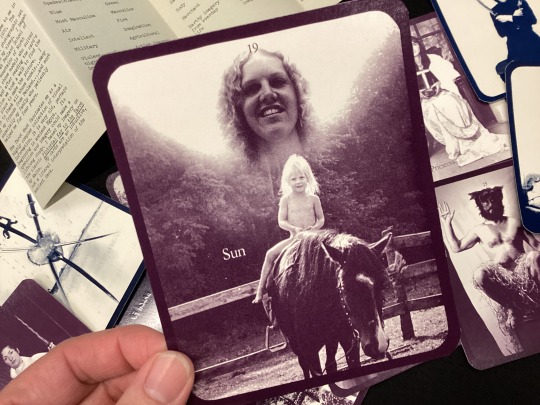
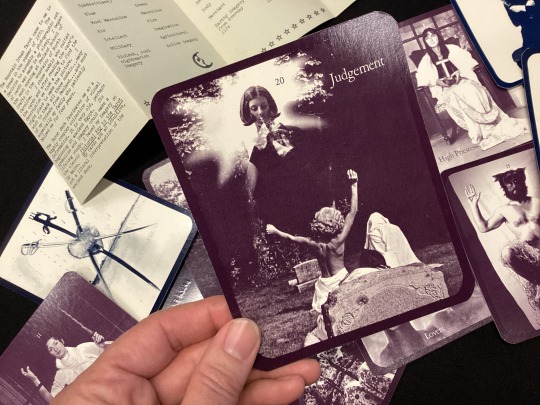
“The Mountain Dream Tarot came to me in a dream in the summer of 1970. The decision to assemble a photographic set of cards was made in my sleep. I began the next morning at Penland School in North Carolina. I chose models who suited the cards and after reading the card's description we took a walk to find the right place to make the picture ... I based my imagery on the classic Pictorial Key to the Tarot by Arthur Waite. My cards are an intuitive, not a literal interpretation of the deck.” – Bea Nettles from the original 1975 introduction.
Bea Nettles (b. 1946) is a photographer and writer known for experimenting with alternative photographic processes. In 1975, Nettles created a set of monochrome photographic tarot cards to foretell the future. The Fine Arts Library owns the third edition of these tarot cards. You can request this set and other tarot card decks in the Special Collections Study Room!
Mountain dream tarot : a deck of 78 photographic cards
Nettles, Bea, 1946- 3rd edition. 2012 78 cards ; 14 x 9 cm in drawstring bag English HOLLIS number: 99157019479903941
#WomensHistoryMonth#BeaNettles#SpecialCollections#TarotCards#MountainDreamTarot#HarvardFineArtsLibrary#Fineartslibrary#Harvard#HarvardLibrary
16 notes
·
View notes
Text


MARIANNE FAITHFULL (1946-Died January 30th 2025,at 78). English singer and actress. She achieved popularity in the 1960s with the release of her UK top 5 single "As Tears Go By", and became one of the leading female artists of the British Invasion in the United States.
Born in Hampstead, London, Faithfull began her career in 1964 after attending a party for the Rolling Stones, where she was discovered by Andrew Loog Oldham. Her 1965 debut studio album Marianne Faithfull, released simultaneously with her studio album Come My Way, was a huge success and was followed by further albums on Decca Records. From 1966 to 1970 she had a highly publicised romantic relationship with Mick Jagger. Her popularity was enhanced by film roles such as those in I'll Never Forget What's'isname (1967), The Girl on a Motorcycle (1968) and Hamlet (1969). Her popularity was overshadowed by personal problems in the 1970s, when she became anorexic, homeless and addicted to heroin.
Faithfull was noted for her distinctive melodic, high-register vocals during her 1960s musical career. Her voice was altered by severe laryngitis and persistent drug abuse during the 1970s, which left her sounding permanently raspy, cracked and lower in pitch. The new sound was praised as "whisky soaked" by some critics and was seen as having helped to capture the raw emotions expressed in her music.
After a long absence, Faithfull made a musical comeback in 1979 with the release of a critically acclaimed seventh studio album, Broken English. The album was a commercial success and marked a resurgence of her musical career. Broken English earned Faithfull a nomination for a Grammy Award for Best Female Rock Vocal Performance and is regarded as her "definitive recording". She followed this with a series of studio albums including Dangerous Acquaintances (1981), A Child's Adventure (1983) and Strange Weather (1987). Faithfull wrote three books about her life: Faithfull: An Autobiography (1994), Memories, Dreams & Reflections (2007) and Marianne Faithfull: A Life on Record (2014).
Faithfull received the World Lifetime Achievement Award at the 2009 Women's World Awards, and in 2011 she was made a Commandeur of the Ordre des Arts et des Lettres by the government of France.Marianne Faithfull - Wikipedia
#Marianne Faithful#English Musicians#British Musicians#The Rolling Stones#Mick Jagger#English Actresses#British Actresses#Actresses#Notable Deaths in January 2025#Notable Deaths in 2025
3 notes
·
View notes
Text

July 23, 2024
Happy Birthday Abigail Rogan
Abigail Rogan (known as Abigail; born 23 July 1946) is an English-born retired actress, particularly of television soap operas and film, and was also briefly a vocalist.
She emigrated from London in 1968 and became one of Australia’s significant sex symbols of the early 1970s. She was promoted as a sultry blonde siren, like Marilyn Monroe and Brigitte Bardot.
More Info: https://flashvintage.co.uk/2024/03/24/abigail-rogan/
7 notes
·
View notes
Text
Birthdays 1.6
Beer Birthdays
Gottlieb Heileman (1824)
Caspar Ruff (1844)
Bryan Roth (1985)
Five Favorite Birthdays
Rowan Atkinson; English comedian (1955)
Gustave Dore; artist (1832)
Kahil Gibran; philosopher, poet (1883)
Carl Sandburg; poet, writer (1878)
Earl Scruggs; bluegrass musician (1924)
Famous Birthdays
Joey Lauren Adams; actor, comedian (1911)
Syd Barrett; rock musician (1946)
Max Bruch; composer (1838)
John DeLorean; automaker (1925)
Sandy Denny; country singer (1941)
E.L. Doctorow; writer (1931)
Robert Englund; actor (1949)
Bonnie Franklin; actor (1944)
Charles Haley; San Francisco DE (1964)
Louis Harris; pollster (1921)
Sherlock Holmes; fictional detective (1854)
Joan of Arc; French hero (1412)
Howie Long; football player (1960)
Nancy Lopez; golfer (1957)
Anthony Minghella; film director (1954)
Tom Mix; actor (1880)
Jacques-Etienne Montgolfier; balloonist (1745)
Sun Myung Moon; evangelist (1920)
Pepe Le Pew; cartoon character (1945)
Sam Rayburn; politician (1882)
Gabrielle Reece; volleyball player (1970)
Richard II; king of England (1367)
Alexander Scriabin; composer (1872)
John Singleton; film director (1968)
Jedediah Smith; explorer (1799)
Vic Tayback; actor (1929)
Danny Thomas; actor (1914)
Alan Watts; English writer (1916)
Kim Wilson; rock musician (1951)
Paul Wilson; R&B singer (1935)
Loretta Young; actor (1913)
Malcolm Young; rock musician (1953)
3 notes
·
View notes
Photo

Battle of Britain
The Battle of Britain, dated 10 July to 31 October by the UK Air Ministry, was an air battle between the German Luftwaffe and British Royal Air Force and allies during the Second World War (1939-45). The Luftwaffe failed to achieve air superiority, necessary for any future invasion of Britain, and so the RAF won a precious victory that finally stopped the westward expansion of Nazi Germany.
The Fall of France
Germany attacked Poland on 1 September 1939, and so World War II began. German forces swept through the Low Countries and France in 1940. The British Expeditionary Force in France, cut off from the south of the country, was obliged to withdraw 340,000 men in the Dunkirk Evacuation of May-June. Paris was occupied on 14 June. The French government surrendered on 22 June. The unthinkable had happened, France had fallen, and it was now expected that the German leader Adolf Hitler (1889-1945) would next invade Britain in Operation Sea Lion. First, it was essential to establish air superiority if the invasion fleet was to safely cross the English Channel. The commander-in-chief of the German Air Force Hermann Göring (1893-1946) promised Hitler that his Luftwaffe would destroy Britain's air power by directly engaging fighter planes and bombing airfields and aircraft factories. As the British Prime Minister Winston Churchill (1874-1965) told Parliament on 18 June: "The Battle of France is over. I expect the battle of Britain is about to begin" (Overy, 9).
Britain was hardly ready for the war that so swiftly came to its shores. In total, the RAF had lost 931 aircraft and suffered over 1,500 casualties in the defence of France, including the loss of over 500 pilots. The RAF desperately needed more pilots and aircraft to defend Britain in the coming months, which would prove to be a pivotal period of the entire five-year conflict. According to the secretary of Air Chief Marshal Hugh Dowding (1882-1970), the Commander-in-Chief of RAF Fighter Command, Dowding "said he knew full well he could never win the war but he was very conscious of the fact that he was the one man who could easily lose it" (Holmes, 132). The British people were already prepared for the worst. Thousands of children had been evacuated from cities, air raid shelters were being built in people's gardens, the blackout (where no non-essential lights were to show at night) was being enforced, and everyone carried gas masks. The question was where, when, and how would the Germans strike?
Continue reading...
17 notes
·
View notes
Note
was that the bite of 87? hm? hm sans? was it? theb tie? of 87? hm?
The San Francisco 49ers (also written as the San Francisco Forty-Niners and nicknamed the Niners)[7] are a professional American football team based in the San Francisco Bay Area. The 49ers compete in the National Football League (NFL) as a member of the league's National Football Conference (NFC) West division. The team plays its home games at Levi's Stadium in Santa Clara, California, located 38 miles (61 km) southeast of San Francisco. The team is named after the prospectors who arrived in Northern California in the 1849 Gold Rush.[8]
The team was founded in 1946 as a charter member of the All-America Football Conference (AAFC) and joined the NFL in 1949 when the leagues merged.[9][10][11] The 49ers were the first major league professional sports franchise based in San Francisco. They are the 10th oldest franchise in the NFL, and have been family owned and operated exclusively by Italian Americans (Morabito and DeBartolo families, respectively) since the team's inception.[12][13] The team began play at Kezar Stadium in San Francisco before moving to Candlestick Park in 1971 and then to Levi's Stadium in 2014. Since 1988, the 49ers have been headquartered in Santa Clara.
The 49ers won five Super Bowl championships between 1981 and 1994. Four of those came in the 1980s, and were led by Hall of Famers Joe Montana, Jerry Rice, Ronnie Lott, Steve Young, Charles Haley, Fred Dean, and coaches Bill Walsh and George Seifert.[14] They have been division champions 22 times between 1970 and 2023, making them one of the most successful teams in NFL history.[15][16] The 49ers sit alone in NFL history for most playoff wins (38), having been in the league playoffs 30 times (29 times in the NFL and one time in the AAFC), and have also played in the most NFC Championship games (19), hosting 11 of them, also an NFC record. The team has set numerous notable NFL records, including most consecutive away games won (18), most points scored in a single postseason (131), most consecutive seasons leading the league in scoring (4), most consecutive games scored (420 games from 1977 to 2004),[17] most field goals in a season (44), most games won in a season (18), and most touchdowns (8) and points scored (55) in a Super Bowl.[18]
According to Forbes, the 49ers are the sixth most-valuable team in the NFL, valued at $5.2 billion in August 2022.[19] In 2020, they were ranked the 12th most valuable sports team in the world, behind the Los Angeles Rams and above the Chicago Bears.[20] In June 2023, the enterprise branch of the 49ers completed the acquisition of English soccer club Leeds United.[21]
6 notes
·
View notes
Text

Somewhat going against the whole faces theory I put forward, I guess this is what a face would look like on an F unit. I imagine the B unit is faceless, but does have intelligence and can talk with other engines via the MU cable. Or maybe it doesn't and it's just a regular, mundane piece of machinery.
Tennessee & Atlantic Railway really didn't buy that many diesels; in 1940, Charlotte, NC (followed by Asheville in 1946) banned steam and diesel workings within city limits for pollution reasons; so, many routes in the Appalachian Mountains that were already better suited to electrification were staffed by, initially, Baldwin-Westinghouse 2-C+C-2 boxcabs (pictured below in service with the NYNH&H):

and later on, in the 1950s through 1970s, by converted FTs, F2s, F7s, and English Electric-built units to the same design (but regauged) as the ones they built for Victorian Railways:


Until eventually they ended up buying EMD AEM-7s in 1986, having 98 delivered in 1987-93, which displaced their older units.
As such, diesels tended to be reserved for routes avoiding the Blue Ridge Mountains and western North Carolina in particular. Eventually, the cities lifted these laws, but not before the Tennessee & Atlantic was merged with two other neighboring railways into the North Carolina Western Group on January 1, 1968. T&A was the largest merging entity, and so the other railways' operations were restructured to fit theirs.
As for the lore of this/these engine(s) in particular, they're diesels reserved and painted for use with the Mockingbird, a Memphis-Nashville-Atlanta-Jacksonville train (continuing to Miami via SAL) that ran twice a day in both directions (four total), alongside 2A/B, 3A/B, and 4A/B. Built in 1946, F3 1A/B was delivered new to the T&A, where they (or she if we're going by only the A units being alive, which I will write as if is the case from here on) and their sisters started on fast agricultural freight while the steam engines rode out their last few years on the Mockingbird, gaining experience to ensure even higher passenger safety.
During one of these trips, on a stop at Atlanta coming from Jacksonville with Florida agriculture, 1A, or Margaret E. C. French, had a careless driver accidentally top her fuel tank off with water from a pipe still up for their steam; since 1B was still providing power they could still move at first but eventually, French had to stop after her engine block started making noise; the water bent her piston rods. A steam engine that had treated her with open disregard at the yard and 1B had to haul her train to Bowling Green, and her to repair shops in Chattanooga, TN.
Another notable incident happened on January 8, 1955, when 1A nearly collided with a slower passenger train, barely avoiding coupling at a speed difference of 30 mph, after noticing the train before her driver and warning him.
Eventually, on May 31, 1955, the Mockingbird's last steam-hauled trip (pulled by one of the company's many 4-8-4s, which they called "Generals" rather than "Northerns") reached Jacksonville and back, with engine changes at Atlanta, where 1A/B, freshly repainted in the red/maroon/silver scheme depicted at the top of the page (previously in the silver/maroon scheme depicted later down) began to pull the first northbound (train 10). They would handle this job, albiet not necessarily on the same timeslot, for roughly 45 years, before being replaced by custom SD60M-based units in 1999. Amtrak wouldn't take the train over until 2010, at which point, Amtrak's power replaced NCW's, and the SDP60Ms were sold to shortlines.
Generally, these trains had exceptional safety records, with fewer than 10 total incidents over the 1955-99 span. However, 3A/B taking train 14 did collide with the car of the Secretary of Transportation of Georgia in 1974, having left it after it stalled on the level crossing. Nobody was hurt, but train 14 did need to be towed to the station in downtown Atlanta, where the train was taken over by an SD40-2.
Based on Clarabel's face from Tramway Engines - Mavis.
4 notes
·
View notes
Text
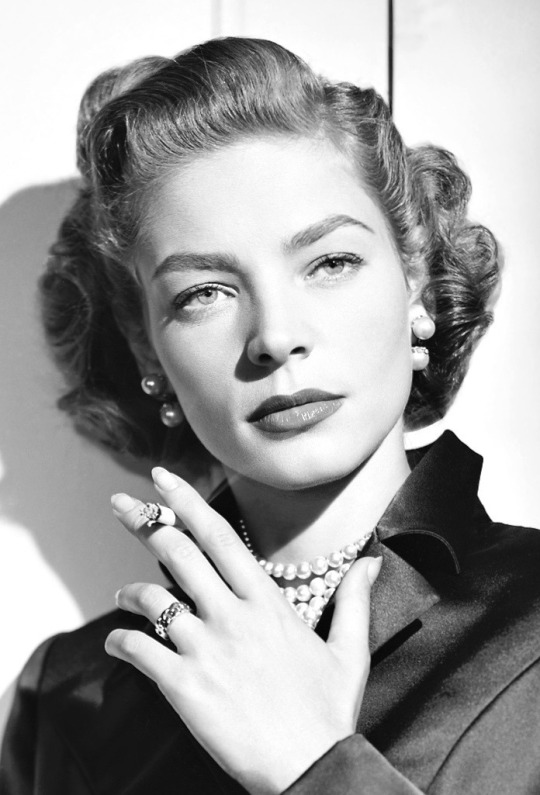
Lauren Bacall for "Young Man with a Horn" in 1950
Betty Joan Perske (September 16, 1924 – August 12, 2014), professionally known as Lauren Bacall, was an American actress. She was named the 20th-greatest female star of classic Hollywood cinema by the American Film Institute and received an Academy Honorary Award in 2009 in recognition of her contribution to the Golden Age of motion pictures. She was known for her alluring, sultry presence and her distinctive, husky voice. Bacall was one of the last surviving major stars from the Golden Age of Hollywood cinema.
Bacall began a career as a model for the Walter Thornton Model Agency before making her film debut at the age of 20 as the leading lady opposite her future husband Humphrey Bogart in To Have and Have Not (1944). She continued in the film noir genre with appearances alongside her new husband in The Big Sleep (1946), Dark Passage (1947), and Key Largo (1948), and she starred in the romantic comedies How to Marry a Millionaire (1953) and Designing Woman (1957). She portrayed the female lead in Written on the Wind (1956) which is considered one of Douglas Sirk's seminal films. She later acted in Harper (1966), Murder on the Orient Express (1974), and The Shootist (1976).
She found a career resurgence for her role in the romantic comedy The Mirror Has Two Faces (1996) for which she earned the Golden Globe Award and the Screen Actors Guild Award, in addition to nominations for the Academy Award and the BAFTA Award for Best Supporting Actress. During the final stage of her career, she gained newfound success with a younger audience for major supporting roles in the films Misery (1990), Dogville (2003), Birth (2004), and the English dubs of the animated films Howl's Moving Castle (2004) and Ernest & Celestine (2012).
For her work on theatre, she made her Broadway debut in Johnny 2x4 (1942). She went on to win two Tony Awards for Best Actress in a Musical for her performances in Applause (1970) and Woman of the Year (1981). She also acted in the play Goodbye Charlie (1959), the farce Cactus Flower (1965), and Wonderful Town (1977). She made her West End debut in The Applause (1970) followed by Sweet Bird of Youth (1985).
7 notes
·
View notes
Text

Jane Birkin, actor and singer, dies aged 76
Best known for the sexually explicit 1969 hit Je t’aime … moi non plus, she found fame in her adopted France
The British-born actor and singer Jane Birkin has been found dead at her home in Paris, the French culture ministry said on Sunday.
Birken, 76, was best known overseas for her 1969 hit in which she and her lover, the late French singer-songwriter Serge Gainsbourg, sang the sexually explicit Je t’aime … moi non plus.
Birkin found fame in her adopted France, catapulted into the public eye by her turbulent relationship with Gainsbourg. Her heavily accented French became her personal style signifier.
She crossed the channel in 1968 at the age of 22 to star in a film alongside Gainsbourg, who was 18 years her senior. It was the start of a 13-year relationship that made them France’s most famous couple, in the spotlight as much for their bohemian and hedonistic lifestyle as for their work.
The doe-eyed Birkin, with her soft voice and androgynous silhouette, quickly became a sex symbol, recording the steamy Je t’aime … moi non plus with a growling Gainsbourg. Banned on radio in several countries and condemned by the Vatican, the song was a worldwide success.
“He and I became the most famous of couples in that strange way because of Je t’aime and because we stuck together for 13 years and he went on being my friend until the day he died. Who could ask for more?” Birkin told CNN in 2006.
“So Paris became my home. I’ve been adopted here. They like my accent,” she said.
Birkin was born in London on 14 December 1946 to an actor mother and naval officer father. At 17, she married the James Bond composer John Barry, with whom she had a daughter, Kate, but the marriage lasted only three years.
She made waves in her film debut in 1966 with a full frontal nude scene in the swinging sixties classic Blow-Up by Michelangelo Antonioni.
After meeting Gainsbourg, 18 years her senior, in Paris on the set of a romantic comedy – he was her co-star – she moved to France permanently. Their musical and romantic relationship was tempestuous. During one of their raging rows, Birkin launched herself into the River Seine after throwing a custard pie in Gainsbourg’s face.
They had a daughter, Charlotte, who became a hugely successful actor and singer.
Birkin finally walked out on France’s favourite bad boy in 1980 and went on to to blaze her own trail. In cinema, she branched out from more ditsy roles to arthouse productions, gaining three nominations at the Césars – France’s Oscars – starting with La Pirate in 1985.
In her about 70 films she has been directed by France’s leading directors, including Bertrand Tavernier, Jean-Luc Godard, Alain Resnais, James Ivory and Agnès Varda.
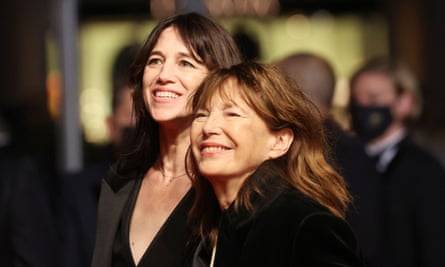
A chronic alcoholic, Gainsbourg died of a heart attack in 1991 aged 62. A few years earlier, he was in the audience to hear Birkin perform her first solo concert at the age of 40 at the Bataclan theatre in Paris.
In 1998 came her first record without Gainsbourg, Á la Légère. But she repeatedly returned to his repertoire, singing his hits around the world accompanied by a full orchestra, including in 2020 in New York where she performed with Iggy Pop.
The English rose of French chanson became something of a national treasure, who preserved the accent that made the French swoon throughout her life and an endearing air of fragility.
Her life was marked by tragedy, with her eldest daughter Kate Barry, a photographer, apparently committing suicide in 2013. She had leukaemia in the late 1990s and in 2021 suffered a minor stroke.
With her flared jeans, mini-dresses and messy bangs, Birkin was the ultimate It girl in the 1970s. In 1984, Hermès named one of its handbags after her. She was made an Officer of the Order of the British Empire (OBE) in 2001 for her services to acting and British-French cultural relations.
Besides Charlotte and Kate, she had another daughter, the singer Lou Doillon, from her 13-year relationship with the French director Jacques Doillon.
RIP Jane
27 notes
·
View notes